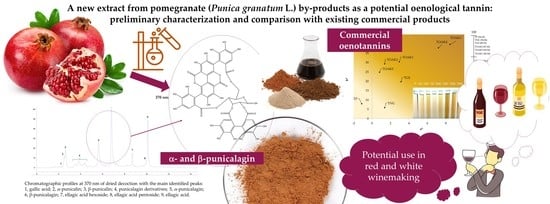A New Extract from Pomegranate (Punica granatum L.) By-Products as a Potential Oenological Tannin: Preliminary Characterization and Comparison with Existing Commercial Products
Abstract
1. Introduction
2. Results and Discussion
3. Materials and Methods
3.1. Chemicals
3.2. Preparation, Characterization, and Preliminarily Purification of the Decoction from Pomegranate Mesocarp (Wonderful Variety)
3.3. Preparation of Solution of the 8 Analyzed Tannins in Model Wine Solution
3.4. Evaluation of Total Phenolic Content
3.4.1. Folin-Ciocalteu Assay
3.4.2. Total Polyphenols Index
3.5. Evaluation of Antiradical Activity by DPPH
3.6. UV-Vis Spectroscopy
3.7. HPLC and HPLC-MS Analysis
3.8. CIEL*a*b* Coordinates
3.9. Tannin Analysis by the OIV Method
3.10. Gelatin Index and Turbidity
3.11. Statistical Analysis
4. Conclusions
Author Contributions
Funding
Conflicts of Interest
References
- OIV. International Oenological Codex. COEI-1-TANINS: 2017. Available online: http://www.oiv.int/public/medias/4093/e-coei-1-tanins.pdf (accessed on 24 August 2020).
- Vignault, A.; Gonzalez-Centeno, M.R.; Pascual, O.; Gombau, J.; Jourdes, M.; Moine, V.; Iturmendi, N.; Canals, J.M.; Zamora, F.; Teissedre, P.L. Chemical characterization, antioxidant properties and oxygen consumption rate of 36 commercial oenological tannins in a model wine solution. Food Chem. 2018, 268, 210–219. [Google Scholar] [CrossRef] [PubMed]
- Vignault, A.; Gombau, J.; Jourdes, M.; Moine, V.; Canals, J.M.; Fermaud, M.; Roudet, J.; Zamora, F.; Teissedre, P.L. Oenological tannins to prevent Botrytis cinerea damage in grapes and musts: Kinetics and electrophoresis characterization of laccase. Food Chem. 2020, 316, 126334. [Google Scholar] [CrossRef]
- González-Centeno, M.R.; Jourdes, M.; Femenia, A.; Simal, S.; Rosselló, C.; Teissedre, P.-L. Proanthocyanidin composition and antioxidant potential of the stem Winemaking byproducts from 10 different grape varieties (Vitis vinifera L.). J. Agric. Food Chem. 2012, 60, 11850–11858. [Google Scholar] [CrossRef] [PubMed]
- Magalhaes, L.M.; Ramos, I.I.; Reis, S.; Segundo, M.A. Antioxidant profile of commercial oenological tannins determined by multiple chemical assays. AJGW 2014, 20, 72–79. [Google Scholar] [CrossRef]
- Obradovic, D.; Schulz, M.; Oatey, M. Addition of natural tannins to enhance the quality of red wine. In Australian & New Zealand Grapegrower & Winemaker; WineMaker: Broadview, Australia, 2005; pp. 52–54. [Google Scholar]
- Farhadi, K.; Esmaeilzadeh, F.; Hatami, M.; Forough, M.; Molaie, R. Determination of phenolic compounds content and antioxidant activity in skin, pulp, seed, cane and leaf of five native grape cultivars in West Azerbaijan province Iran. Food Chem. 2016, 199, 847–855. [Google Scholar] [CrossRef] [PubMed]
- Perez, C.A.; Wei, Y.; Guo, M. Iron-binding and anti-Fenton properties of baicalein and baicalin. J. Inorg. Biochem. 2009, 103, 326–332. [Google Scholar] [CrossRef]
- Karamać, M.; Pegg, R.B. Limitations of the tetramethylmurexide assay for investigating the Fe(II) chelation activity of phenolic compounds. J. Agric. Food Chem. 2009, 57, 6425–6431. [Google Scholar] [CrossRef]
- Navarro, M.; Kontoudakis, N.; Giordanengo, T.; Gómez-Alonso, S.; García-Romero, E.; Fort, F.; Canals, J.M.; Hermosín-Gutíerrez, I.; Zamora, F. Oxygen consumption by oak chips in a model wine solution; Influence of the botanical origin, toast level and ellagitannin content. Food Chem. 2016, 199, 822–827. [Google Scholar] [CrossRef]
- Pascual, O.; Vignault, A.; Gombau, J.; Navarro, M.; Gomez-Alonso, S.; Garcia-Romero, E.; Canals, J.M.; Hermosin-Gutierrez, I.; Teissedre, P.L.; Zamora, F. Oxygen consumption rates by different oenological tannins in a model wine solution. Food Chem. 2017, 234, 26–32. [Google Scholar] [CrossRef]
- Canuti, V.; Puccioni, S.; Giovani, G.; Salmi, M.; Rosi, I.; Bertuccioli, M. Effect of oenotannin addition on the composition of sangiovese wines from grapes with different characteristics. Am. J. Enol. Vitic. 2012, 63, 220–231. [Google Scholar] [CrossRef]
- Trouillas, P.; Sancho-García, J.C.; De Freitas, V.; Gierschner, J.; Otyepka, M.; Dangles, O. Stabilizing and modulating color by copigmentation: Insights from theory and experiment. Chem. Rev. 2016, 116, 4937–4982. [Google Scholar] [CrossRef] [PubMed]
- Neves, A.C.; Spranger, M.I.; Zhao, Y.Q.; Leandro, M.C.; Sun, B.S. Effect of addition of commercial grape seed tannins on phenolic composition, chromatic characteristics, and antioxidant activity of red wine. J. Agric. Food Chem. 2010, 58, 11775–11782. [Google Scholar] [CrossRef] [PubMed]
- Versari, A.; du Toit, W.; Parpinello, G.P. Oenological tannins: A review. Aust. J. Grape Wine Res. 2013, 19, 1–10. [Google Scholar] [CrossRef]
- Ribéreau-Gayon, P.; Dubourdieu, D.; Donèche, B. Handbook of Enology, 2nd ed.; Hoboken, N.J., Ed.; John Wiley: Chichester, UK, 2006. [Google Scholar]
- Mierczynska-Vasilev, A.; Smith, P.A. Current state of knowledge and challenges in wine clarification. Aust. J. Grape Wine Res. 2015, 615–626. [Google Scholar] [CrossRef]
- Preys, S.; Mazerolles, G.; Courcoux, P.; Samson, A.; Fischer, U.; Hanafi, M.; Bertran, D.; Cheynier, V. Relationship between polyphenolic composition and some sensory properties in red wines using multiway analyses. Anal. Chim. Acta 2006, 563, 126–136. [Google Scholar] [CrossRef]
- Vivas, N.; Nonier, M.-F.; de Gaulejac, N.V.; Absalon, C.; Bertrand, A.; Mirabel, M. Differentiation of proanthocyanidin tannins from seeds, skins and stems of grapes (Vitis vinifera) and heartwood of Quebracho (Schinopsis balansae) by matrixassisted laser desorption/ionization time-of-flight mass spectrometry and thioacidolysis/liquid chromatography/electrospray ionization mass spectrometry. Anal. Chim. Acta 2004, 513, 247–256. [Google Scholar] [CrossRef]
- Lempereur, V.; Blayteyron, L.; Labarbe, B.; Saucier, C.; Klebek, H.; Glories, Y. Groupe national de travail sur les tanins oenologiques: Premiers résultats. Rev. Française d’Oenologie Paris 2002, 196, 23–29. [Google Scholar]
- Schofield, P.; Mbugua, D.M.; Pell, A.N. Analysis of condensed tannins: A review. Anim. Feed Sci. Technol. 2001, 91, 21–40. [Google Scholar] [CrossRef]
- Jourdes, M.; Pouysegu, L.; Deffieux, D.; Teissedre, P.-L.; Quideau, S. Hydrolyzable tannins: Gallotannins and ellagitannins. In Natural Products: Phytochemistry, Botany and Metabolism of Alkaloids, Phenolics and Terpenes; Springer Link: New York, NY, USA, 2013; pp. 1795–2010. [Google Scholar] [CrossRef]
- Yoshida, T.; Hatano, T.; Ito, H.; Okuda, T. Structural diversity and antimicrobial activities of ellagitannins. In Chemistry and Biology of Ellagitannins: An Underestimated Class of Bioactive Plant Polyphenols; World Scientific Publishing Co.: Singapore, 2009; pp. 55–93. [Google Scholar] [CrossRef]
- Okuda, T.; Yoshida, T.; Hatano, T. Correlation of oxidative transformation of hydrolysable tannins and plant evolution. Phytochemistry 2000, 55, 513–529. [Google Scholar] [CrossRef]
- Okuda, T.; Yoshida, T.; Hatano, T.; Ito, H. Ellagitannins renewed the concept of tannins. In Chemistry and Biology of Ellagitannins—An Underestimated Class of Bioactive Plant Polyphenols; Quideau, S., Ed.; Imperial College Press/World Scientific Publishing: Singapore, 2009. [Google Scholar] [CrossRef]
- Yamada, H.; Wakamori, S.; Hirokane, T.; Ikeuchi, K.; Matsumoto, S. Structural revisions in natural ellagitannins. Molecules 2018, 23, 1901. [Google Scholar] [CrossRef]
- Landete, J.M. Ellagitannins, ellagic acid and their derived metabolites: A review about source, metabolism, functions and health. Food Res. Int. 2011, 44, 1150–1160. [Google Scholar] [CrossRef]
- Fischer, U.A.; Carle, R.; Kammerer, D.R. Identification and quantification of phenolic compounds from pomegranate (Punica granatum L.) peel, mesocarp, aril and differently produced juices by HPLC-DAD–ESI/MS(n). Food Chem. 2011, 127, 807–821. [Google Scholar] [CrossRef] [PubMed]
- Okuda, T.; Yoshida, T.; Hatano, T. Classification of oligomeric hydrolysable tannins and specificity of their occurrence in plants. Phytochemistry 1993, 32, 507–521. [Google Scholar] [CrossRef]
- Jeremic, J.; Vonglunngam, I.; Ricci, A.; Parpinello, G.P.; Versari, A. The Oxygen Consumption Kinetics of Commercial Oenological Tannins in Model Wine Solution and Chianti Red Wine. Molecules 2020, 25, 1215. [Google Scholar] [CrossRef] [PubMed]
- Chassaing, S.; Lefeuvre, D.; Jacquet, R.; Jourdes, M.; Ducasse, L.; Galland, S.; Grelard, A.; Saucier, C.; Teissedre, P.-L.; Dangles, O.; et al. Physicochemical studies of new anthocyano-ellagitannin hybrid pigments: About the origin of the influence of oak C-glycosidic ellagitannins on wine color. Eur. J. Org. Chem. 2010, 1, 55–63. [Google Scholar] [CrossRef]
- Vignault, A.; Gombau, J.; Pascual, O.; Jourdes, M.; Moine, V.; Canals, J.M.; Zamora, F.; Teissedre, P.L. Copigmentation of malvidin-3-O-monoglucoside by oenological tannins: Incidence on wine model color in function of botanical origin, pH and ethanol content. Molecules 2019, 24, 1448. [Google Scholar] [CrossRef]
- Holland, D.; Hatib, K.; Bar-ya, I. Pomegranate: Botany, Horticulture, Breeding. Hort. Rev. 2009, 35, 127–192. [Google Scholar] [CrossRef]
- Hussein, L.; Gouda, M.E.L. Pomegranate: Cultivation, Pomological Properties, Processing, Global Market and Health Benefits. Pomegranate: Cultivation, Antioxidant and Health Benefits; Food science and technology, Nova Science Publisher: New York, NY, USA, 2018; pp. 267–302. [Google Scholar]
- Gil, M.I.; Tomas-Barberan, F.A.; Hess-Pierce, B.; Holcroft, D.M.; Kader, A.A. Antioxidant activity of pomegranate juice and its relationship with phenolic composition and processing. J. Agric. Food Chem. 2000, 48, 4581–4589. [Google Scholar] [CrossRef]
- Scaioli, E.; Belluzzi, A.; Ricciardello, L.; Del Rio, D.; Rotondo, E.; Mena, P.; Derlindati, E.; Danesi, F. Pomegranate juice to reduce fecal calprotectin levels in inflammatory bowel disease patients with a high risk of clinical relapse: Study protocol for a randomized controlled trial. Trials 2019, 20, 327. [Google Scholar] [CrossRef]
- Kujawska, M.; Jourdes, M.; Kuprik, M.; Szulc, M.; Szaefer, H.; Chmielarz, P.; Kreiner, G.; Krajka-Kuzniak, V.; Mikolajczak, P.L.; Teissedre, P.-L.; et al. Neuroprotective Effects of Pomegranate Juice against Parkinson’s Disease and Presence of Ellagitannins-DerivedMetabolite—Urolithin A—In the Brain. Int. J. Mol. Sci. 2020, 21, 202. [Google Scholar] [CrossRef]
- Tortora, K.; Femia, A.P.; Romagnoli, A.; Sineo, I.; Khatib, M.; Mulinacci, N.; Caderni, G. Pomegranate By-Products in Colorectal Cancer Chemoprevention: Effects in Apc-Mutated Pirc Rats and Mechanistic Studies In Vitro and Ex Vivo. Mol. Nutr. Food Res. 2018, 62, 1–10. [Google Scholar] [CrossRef]
- Wu, Y.; Zhu, C.; Zhang, Y.; Li, Y.; Sun, J. Immunomodulatory and antioxidant effects of pomegranate peel polysaccharides on immunosuppressed mice. Int. J. Biol. Macromol. 2019, 137, 504–551. [Google Scholar] [CrossRef] [PubMed]
- Parisio, C.; Lucarini, E.; Micheli, L.; Toti, A.; Khatib, M.; Mulinacci, N.; Calosi, L.; Bani, D.; di Cesare Mannelli, L.; Ghelardini, C. Pomegranate mesocarp against colitis-induced visceral pain in rats: Effects of a decoction and its fraction. Int. J. Mol. Sci. 2020, 21, 4304. [Google Scholar] [CrossRef] [PubMed]
- Seeram, N.; Aviram, M.; Zhang, J.; Henning, S.; Feng, L.; Dreher, M.; Heber, D. Comparison of antioxidant potency of commonly consumed polyphenol-rich beverages in United States. J. Agric. Food Chem. 2008, 56, 1415–1422. [Google Scholar] [CrossRef] [PubMed]
- Balli, D.; Cecchi, L.; Khatib, M.; Bellumori, M.; Cairone, F.; Carradori, S.; Zengin, G.; Cesa, S.; Innocenti, M.; Mulinacci, N. Characterization of Arils Juice and Peel Decoction of Fifteen Varieties of Punica granatum L.; A Focus on Anthocyanins, Ellagitannins and Polysaccharides. Antioxidants 2020, 9, 238. [Google Scholar] [CrossRef]
- Singh, B.; Pal, J.; Kaur, A.; Singh, N. Phenolic compounds as beneficial phytochemicals in pomegranate (Punica granatum L.) peel: A review. Food Chem. 2018, 261, 75–86. [Google Scholar] [CrossRef]
- Khatib, M.; Giuliani, C.; Rossi, F.; Adessi, A.; Al-Tamimi, A.; Mazzola, G.; Mulinacci, N. Polysaccharides from by-products of the Wonderful and Laffan pomegranate varieties: New insight into extraction and characterization. Food Chem. 2017, 235, 58–66. [Google Scholar] [CrossRef]
- Talekar, S.; Patti, A.F.; Vijayraghavan, R.; Arora, A. An integrated green biorefinery approach towards simultaneous recovery of pectin and polyphenols coupled with bioethanol production from waste pomegranate peels. Bioresour. Technol. 2018, 266, 322–334. [Google Scholar] [CrossRef]
- Peng, Z.; Iland, P.G.; Oberholster, A.; Sefton, M.A. Analysis of pigmented polymers in red wine by reverse phase HPLC. Aust. J. Grape Wine Res. 2002, 8, 70–75. [Google Scholar] [CrossRef]
- Obreque-Slier, E.; Pena-Neira, A.; Lopez-Solis, R.; Ramirez-Escudero, C.; Zamora-Marin, F. Phenolic characterization of commercial enological tannins. Eur. Food Res. Technol. 2009, 229, 859–866. [Google Scholar] [CrossRef]
- Herderich, M.J.; Smith, P.A. Analysis of grape and wine tannins: Methods, applications and challenges. Aust. J. Grape Wine Res. 2005, 11, 205–214. [Google Scholar] [CrossRef]
- Laghi, L.; Parpinello, G.P.; Del Rio, D.; Calani, L.; Mattioli, A.U.; Versari, A. Fingerprint of enological tannins by multiple techniques approach. Food Chem. 2010, 121, 783–788. [Google Scholar] [CrossRef]
- Bertrand, A.; Vivas, N.; Kahn, N.; Caillet, M.M. Characterisation of proanthocyanidins from grapes and from the heartwood of quebracho. The tailored use of tannins. Asvo Proc.-Adv. Tann. Tann. Manag. 2012, 32–35. [Google Scholar]
- Vivas, N. Diversità dei preparati commerciali di estratti vegetali ad uso enologico. In Prodotti di Trattamento ed Ausiliari di Elaborazione dei Mosti e dei Vini, 1st ed.; Bertrand, A., Canal-Llaubères, R.M., Feuillat, M., Hardy, G., Lamadon, F., Lonvaud-Funel, A., Pellerin, P., Vivas, N., Eds.; Eno-one: Reggio Emilia, Italy, 2002; pp. 143–163. [Google Scholar]
- Singleton, V.L.; Orthofer, R.; Lamuela-Raventos, R.M. Analysis of total phenols and other oxidation substrates and antioxidants by means of the Folin-Ciocalteu reagent. Meth. Enzymol. 1999, 299, 152–178. [Google Scholar] [CrossRef]
- Dewanto, V.; Wu, X.; Adom, K.K.; Liu, R.H. Thermal processing enhances the nutritional value of tomatoes by increasing total antioxidant activity. J. Agric. Food Chem. 2002, 50, 3010–3014. [Google Scholar] [CrossRef] [PubMed]
- Ribereau-Gayon, P. Le dosage des composés phénoliques totaux dans les vins rouges. Chim. Anal. 1970, 52, 627–631. [Google Scholar] [CrossRef]
- Brand-Williams, W.; Cuvelier, M.E. Use of a free radical method to evaluate the antioxidant activity. LWT-Food Sci. Technol. 1995, 28, 25–30. [Google Scholar] [CrossRef]
- Balli, D.; Tozzi, F.; Khatib, M.; Adessi, A.; Malgarejo, P.; Masciandaro, G.; Giordani, E.; Innocenti, M.; Mulinacci, N. Purple Queen® fruits of Punica granatum L.: Nutraceutical properties and unconventional growing substrates. J. Berry Res. 2020, in press. [Google Scholar] [CrossRef]
- del Alaya, F.; Echavarru, J.F.; Negueruela, A.I. A new simplified method for measuring the color of wines. I. Red and Rosé Wines. Am. J. Enol. Vitic. 1997, 48, 357–363. [Google Scholar]
- CIE. Colorimetry, 2nd ed.; Publication CIE 15.2: Vienna, Austria, 1986. [Google Scholar]
- Mirabel, M. Caracteristiques Chimiques et Organoleptiques des Tanins des Raisins de Vitis vinifera var. Merlot et Cabernet Sauvignon Issus de Differents Terroirs Bordelais. Ph.D. Thesis, Université Victor Segalen Bordeaux, Bordeaux, France, 2000. [Google Scholar]
Sample Availability: Not available. |
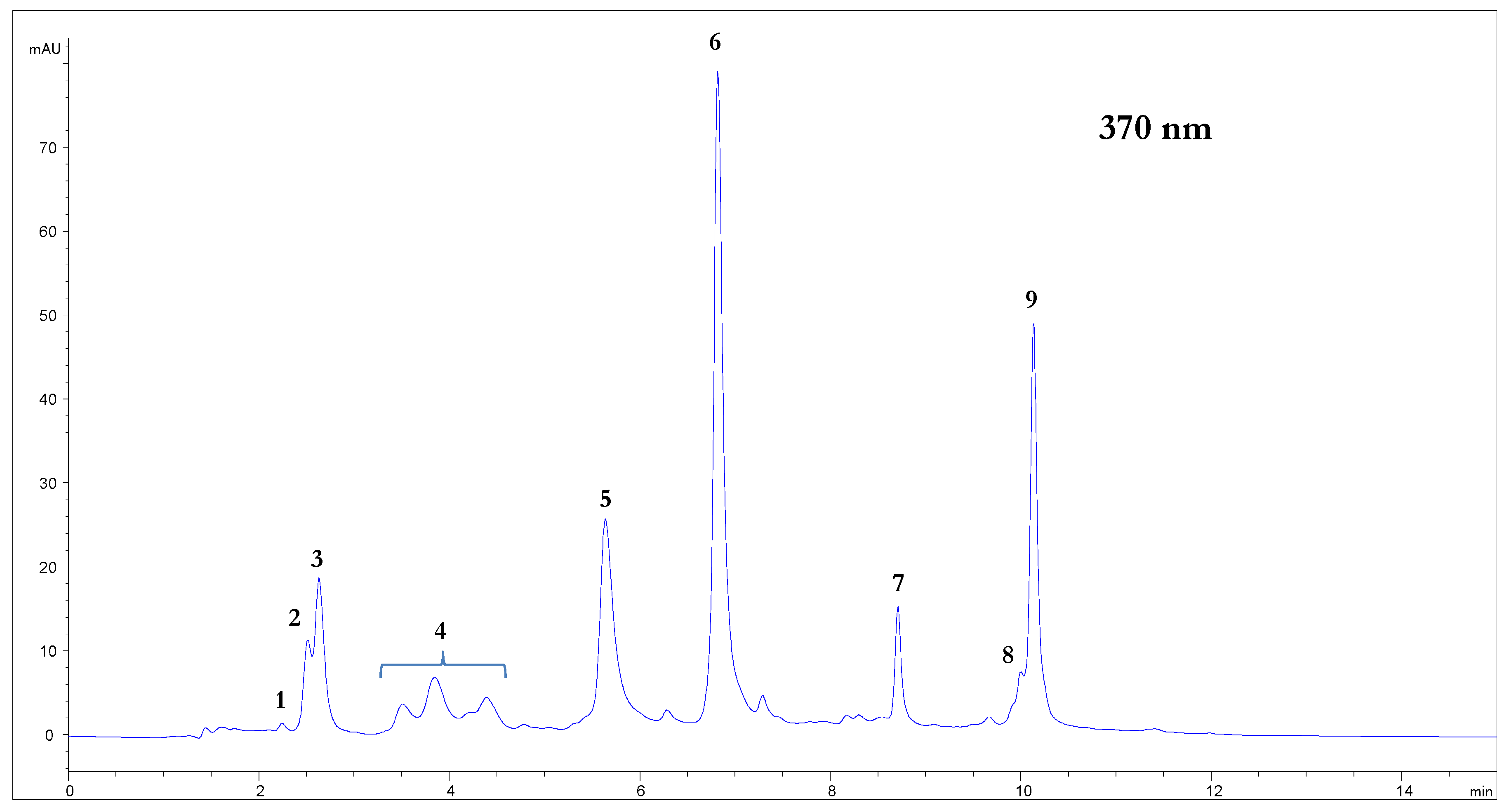
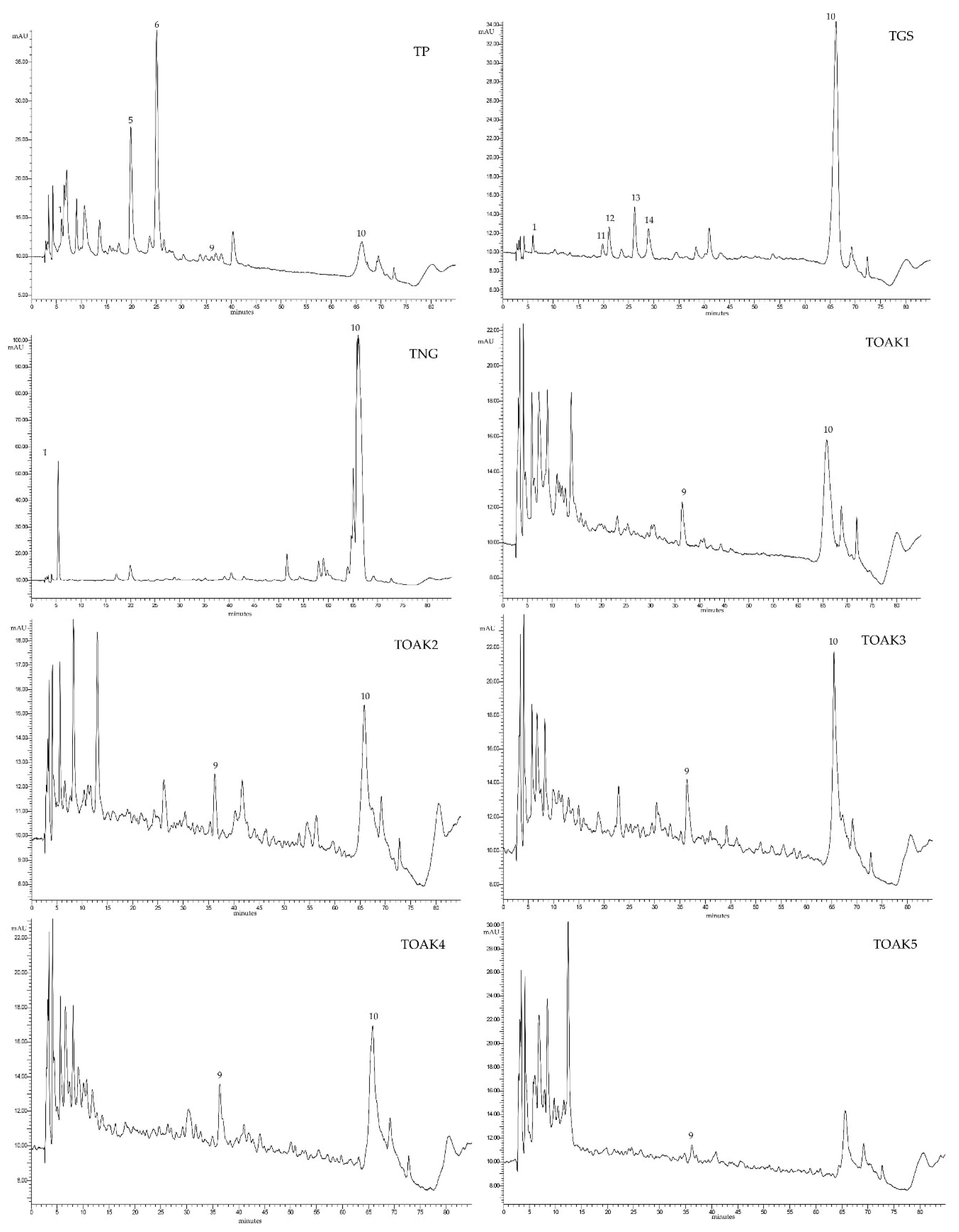
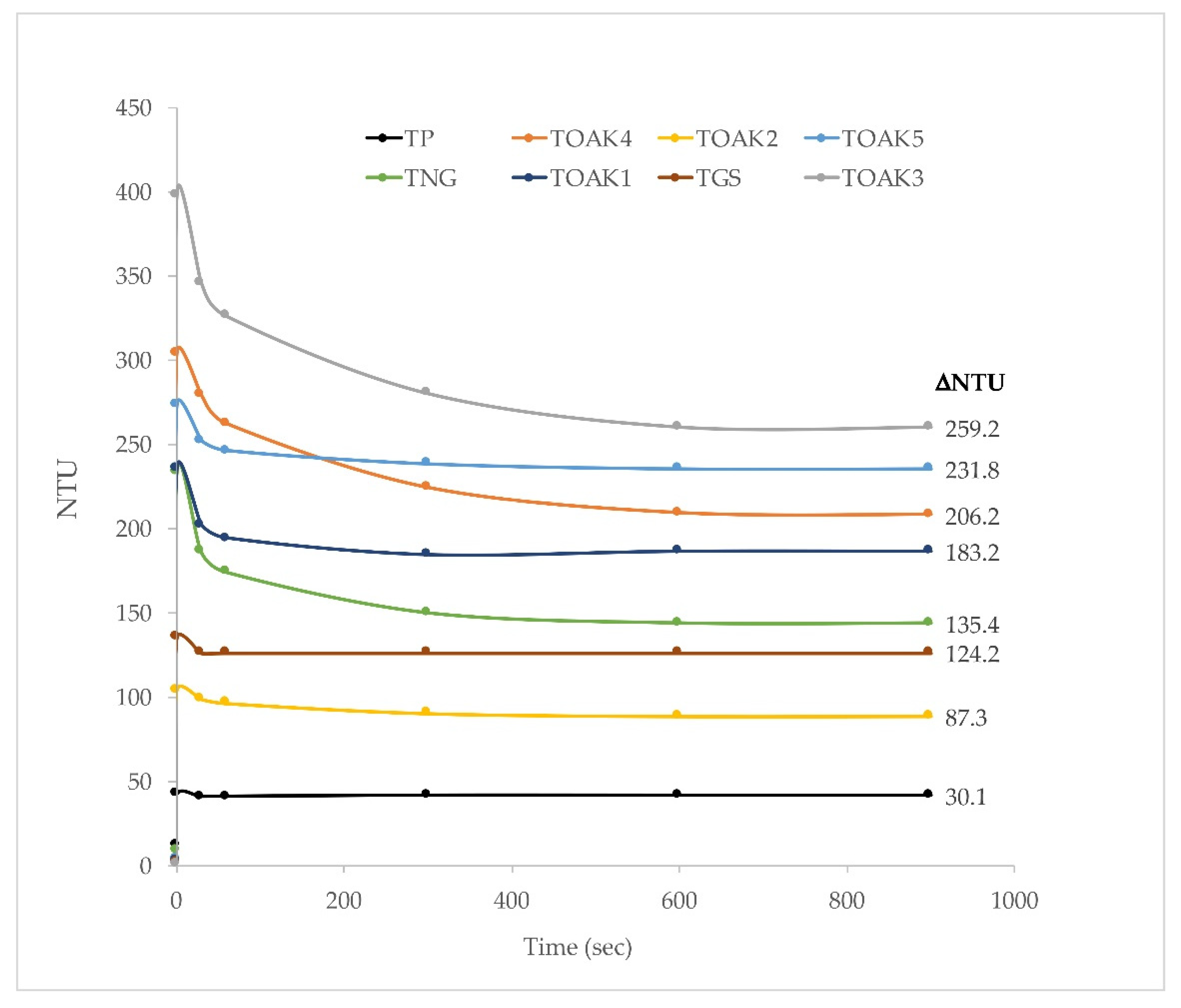

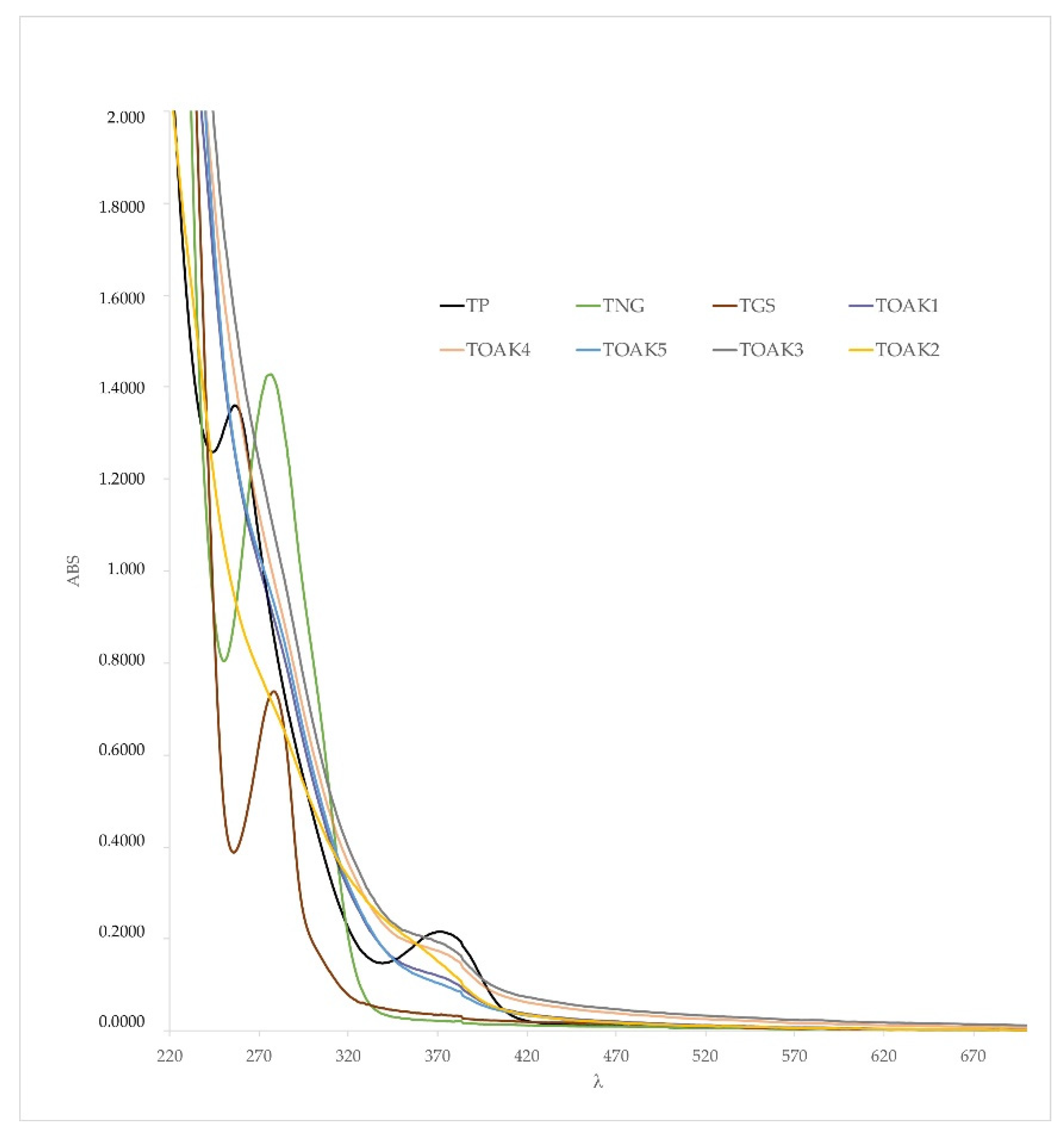

| Tannin Name | Code | Botanical Origin | Type of Tannin |
|---|---|---|---|
| Pomegranate tannin | TP | Pomegranate | Hydrolyzable (Ellagic) |
| Grape seed tannin | TGS | Grape seed | Condensed (procyanidin) |
| Nut gall tannin | TNG | Nut gall | Gallotannin |
| Oak tannin 1 | TOAK1 | Oak | Hydrolyzable (Ellagic) |
| Oak tannin 2 | TOAK2 | Oak | Hydrolyzable (Ellagic) |
| Oak tannin 3 | TOAK3 | Oak | Hydrolyzable (Ellagic) |
| Oak tannin 4 | TOAK4 | Oak | Hydrolyzable (Ellagic) |
| Oak tannin 5 | TOAK5 | Oak | Hydrolyzable (Ellagic) |
| Sample Code | TPC (mg gallic acid/g) | TPI (Abs280nm) | AA (%) | AA/TPC |
|---|---|---|---|---|
| TP | 273 a | 7.62 a | 68.2 a | 0.25 |
| TGS | 601 c | 15.38 c | 79.5 b | 0.13 |
| TNG | 820 e | 26.64 h | 93.7 e | 0.11 |
| TOAK1 | 608 cd | 18.33 e | 92.6 de | 0.15 |
| TOAK2 | 482 b | 14.26 b | 83.1 c | 0.17 |
| TOAK3 | 693 d | 21.45 g | 91.5 de | 0.13 |
| TOAK4 | 690 d | 18.70 f | 90.6 d | 0.13 |
| TOAK5 | 585 c | 18.00 d | 92.5 de | 0.16 |
| F-value | 126.06 | 31124 | 97.28 | |
| p-value | <0.0001 | <0.0001 | <0.0001 | |
| Standard error | 14.52 | 0.0002 | 1.17 |
© 2020 by the authors. Licensee MDPI, Basel, Switzerland. This article is an open access article distributed under the terms and conditions of the Creative Commons Attribution (CC BY) license (http://creativecommons.org/licenses/by/4.0/).
Share and Cite
Canuti, V.; Cecchi, L.; Khatib, M.; Guerrini, L.; Mulinacci, N.; Zanoni, B. A New Extract from Pomegranate (Punica granatum L.) By-Products as a Potential Oenological Tannin: Preliminary Characterization and Comparison with Existing Commercial Products. Molecules 2020, 25, 4460. https://doi.org/10.3390/molecules25194460
Canuti V, Cecchi L, Khatib M, Guerrini L, Mulinacci N, Zanoni B. A New Extract from Pomegranate (Punica granatum L.) By-Products as a Potential Oenological Tannin: Preliminary Characterization and Comparison with Existing Commercial Products. Molecules. 2020; 25(19):4460. https://doi.org/10.3390/molecules25194460
Chicago/Turabian StyleCanuti, Valentina, Lorenzo Cecchi, Mohamad Khatib, Lorenzo Guerrini, Nadia Mulinacci, and Bruno Zanoni. 2020. "A New Extract from Pomegranate (Punica granatum L.) By-Products as a Potential Oenological Tannin: Preliminary Characterization and Comparison with Existing Commercial Products" Molecules 25, no. 19: 4460. https://doi.org/10.3390/molecules25194460
APA StyleCanuti, V., Cecchi, L., Khatib, M., Guerrini, L., Mulinacci, N., & Zanoni, B. (2020). A New Extract from Pomegranate (Punica granatum L.) By-Products as a Potential Oenological Tannin: Preliminary Characterization and Comparison with Existing Commercial Products. Molecules, 25(19), 4460. https://doi.org/10.3390/molecules25194460







